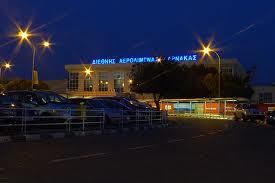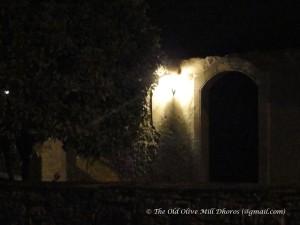Having bought our tickets we arrived at Heathrow airport in plenty of time; both children were very excited to see their plane.
Armed with plenty of activities to keep them amused throughout the journey and our stopover in Bucharest, we boarded the plane. I can’t remember much about the plane journey, I only really remember not recognising what we were given to eat, and the plane seemed to shudder more than most that we had been on, but it was a cheap flight, so we weren’t complaining. I found this photo on Google images from 2007 of a Tarom meal, can you imagine what we were given in 1992, 15 years earlier?
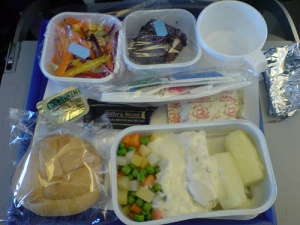
It didn’t seem long before we had landed in Bucharest: Now the fun really did begin to turn ugly: 1st we learnt before we had even disembarked, (about the only time we were given clear information the whole time we were in Bucharest airport!) that our on going plane had been delayed by 4 or 5 hours! Once in the airport; everywhere you looked there were mean looking men in outdated clothes and uniforms carrying machine guns and pistols! The arrivals hall looked like some ancient hangar from an old cold war spy movie; cold, desolate and mean

People of all descriptions and types were lying or sitting on the floor or queuing up for who knows what. (if there were any signs they were all in Romanian). At the time I was very naive and did not have the luxury of a state of the art’s computer or broadband connections to Google and Wikipedia; which we take so much for granted these days. If you want to know anything it is at the end of your fingertips. I only found out today (2014) that 1989 was the year of the massive riots which had overthrown the Communist government. According to Wiki; In 1992, the Stolojan government began an austerity plan, limiting wages and further liberalizing prices. The economic situation deteriorated and inflation as well as unemployment increased substantially.[28] The austerity measures, which by 1995 included a decrease in social spending, led to an increase in poverty. Which I think goes some way to helping me understand what I was seeing in 1992

Back to our arrival at Bucharest International airport; 1st stop toilets; no soap or paper in the Men’s; and very little in the Ladies, but we were lucky; later there was none in ours either. Uncertain of what was happening we decided to look for our departure gate and check out the new departure time; in order to ensure that we didn’t miss our connecting flight and spend any longer than was necessary in Bucharest airport. Up until then I had assumed all international airports would have notices of departures and arrivals; not only were there no notices, you couldn’t ask either as no one spoke English. When I did try to approach anyone official like the uniformed ladies sitting behind bullet proof glass for directions, I was motioned to go away with the butt of a gun. I think we were both beginning to panic, alone in a strange hostile airport with two small children.
Finally with the help of other passengers, we found the huge queue for ongoing flights. This in itself was a nightmare; Bucharest airport at that time was the main flight hub for second and third class citizens entering the Middle East. Very few of the ongoing passengers adhered to any law of western courtesy; men and women were continually pushing in so that we and our two young children kept being pushed further and further back down the queue. Finally having had more than one run in with arrogant Middle Eastern males, who believed that a woman’s place was behind them; we finally made it to the desk and were herded into the next waiting hall. This hall was even bleaker than the arrivals. This time there seemed to be more American students sitting around on the floor than anyone else.
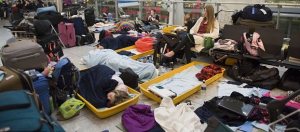
We spoke to one or two of them, who kindly shared their own meagre food with our children. Some had been there for days and didn’t know when the next flight out for them would be. Next minute there was a kerfuffle, as plain clothed police or soldiers came through the crowds demanding all the American passports,which were then forcibly taken from them.

It was all getting a bit too scary! We decided to try and get a drink in the small cafe area to settle our nerves and gain a little reality. As it was we ended up sharing a table with a most beautiful dark haired girl. She was flying out to the Middle East in order to recommence her position as a ‘Belly Dancer’. She had been born, bred and trained in Birmingham. According to our Belly Dancer; the majority of the dancers in the Middle East at that time were born and trained in the UK, as local women were forbidden from following this ancient tradition in public.

We were all getting pretty tired by this time, and realised that we still had no idea of where or when we were departing . Once again I braved the guns, determined to find someone who could help us. Finally I managed to with a guard in a mixture of languages. The next thing we knew, we were all roughly rushed and pushed out of the airport hangar and shoved into some sort of Jeep, again with armed gunmen! We had no idea where we were going; it was the middle of the night and dark. We screamed out across the aerodrome, swerving around large obstacles. Next minute we slammed to a halt, throwing us all off our precarious balance, the children looking as petrified as we felt.

We pulled up alongside an aeroplane revving up and ready to go, we were hauled out of the Jeep and pushed up the steps with very little ceremony, onto our ongoing plane! Within 5 minutes we were airborne.
What would have happened if I hadn’t made that last attempt I’m not sure. We thought we were seasoned travellers and knew the ropes; assuming that one way or another we would be informed of our plane’s due departure. However, with no VDUs or tanoys and the complete absence of the use of the international English language; there was in reality very little we could have done other than what we did. I’m still not sure what happened and why

I can only believe that someone out there was looking out for us; we could have ended up like those poor American students and erstwhile travellers; on an airport floor for who knows how many days. Luckily the return flight was a lot less hazardous and we did finally get to Cyprus and return safely back to England; But we learnt a very important lesson on that 1st flight. Whereas as a student and traveller I had been in all sorts of strange situations myself, we were not prepared to put our own children at this sort of risk again, so I can confidently say we have never flown with Tarom airlines, or visited Bucharest or Romania since that time. I am quite sure that some people will read this and throw their hands up and say how much it has changed and I am sure it has, we have certainly seen many changes in Cyprus over the last twenty years, but that place scared us, not for ourselve,s but for our children and somehow that feeling of helplessness in a foreign country, that at the time didn’t particularly like Western Europe, has sadly stayed with me.
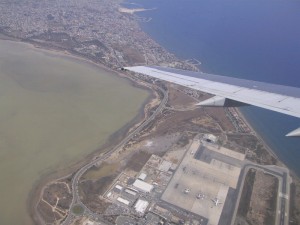
We did however, finally arrive in Cyprus; dirty, scared and tired, but we had a lot more to fathom out before we could get to our destination in the village of Dhoros….tbc


